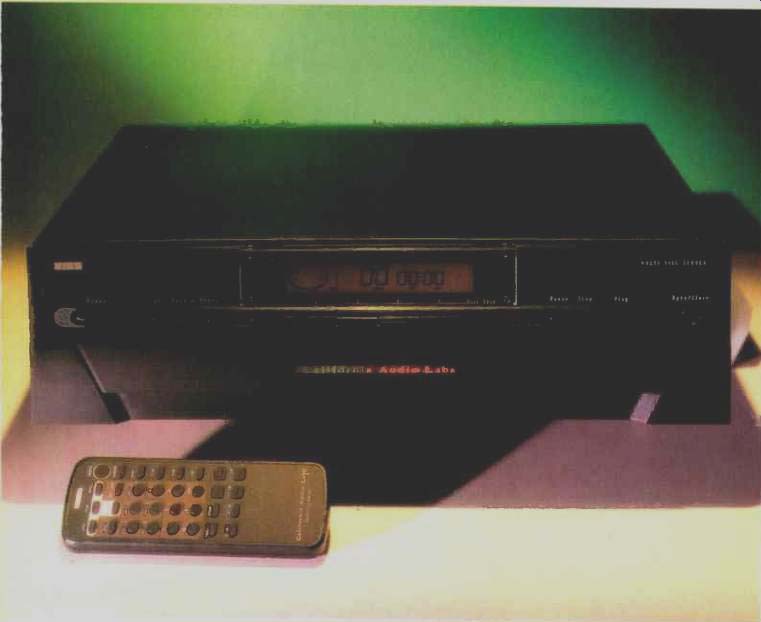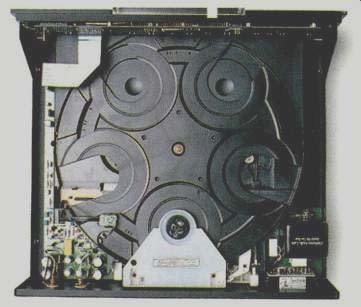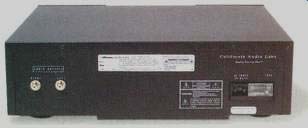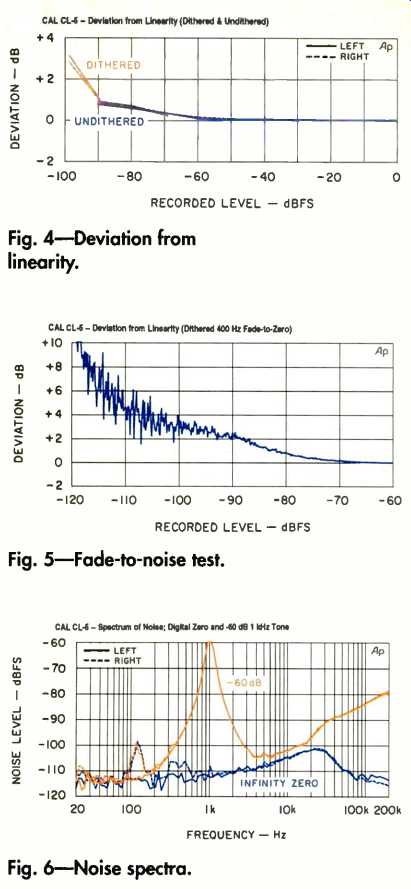
Manufacturer's Specifications:
Dimensions: 17 in. W x 5 in. H x 15 1/4 in. D (43.2 cm x 12.7 cm x 38.7 cm).
Weight: 18 lbs. (8.2 kg).
Price: $1,195.
Company Address: 1751 Langley Ave., Irvine, Cal. 92614; 714/833-3040.
For many serious audiophiles, the term "high-end CD changer" might as well take its place alongside "British cuisine," "political integrity," and "tee totaling audio writer" in the pantheon of timeless oxymorons. However, the popularity of multi-CD playback is such that even esoteric hi fi manufacturers are starting to combine audiophile-oriented technologies with the inarguable convenience of CD changer mechanisms.
California Audio Labs, one of the first American companies to produce its own high-end CD models (nearly a decade ago), now has become one of the first to offer premium multidisc playback. The firm's $1,195 CL-5 Multidisc Server, despite its high-falutin' name, is a classic five-disc carousel. Over the past decade, this compact layout has proven the most popular multidisc format by far, thanks to itscom of a single-disc player's load 'n' play convenience and a changer's ability to play for hours.
The CL-5 is constructed along generally standard five-disc lines, with a full-width, motor-driven tray that extends (in response to a command from either the supplied remote control or the front panel) to reveal five wells set into a plastic rotary tray. Each well is ridged to locate a standard CD, with a con centric indentation to center a 3-inch CD, in case you still have a few that aren't being used as coasters.
The front panel carries the fundamental transport controls (including five disc-select keys and "Disc Skip"), the on/off switch, and a button to open and close the disc drawer. It also carries some less essential controls, for random and repeat play and to turn off the LCD screen's backlighting. You'll have to hunt up the remote for the track-change and two-speed "Search" buttons, the programming controls (which include a 10-key pad), and a few less common functions that I'll describe later.


The remote's layout inspired mixed re views from my fingers. For starters, its 32 keys are rather closely packed, and their small, gray-on-gray lettering is ridiculously hard to read, even in moderate light-for get about a darkened room. On the upside, its buttons are of four different shapes, grouped against backgrounds of different colors and, for the most part, grouped logically. The location of the track-skip and search keys, segregated as far as they could be from the other transport keys (which are in the top rows), struck me as illogical and quite awkward. When opened, the CL-5's disc tray extends only about halfway, uncovering two adjacent cutouts for loading or unloading. A two-speed motorized mechanism slows the drawer down as it approaches its fully open or closed position--pretty slick. However, key-press is always required to close the drawer: The CL-5 does not whir into action when you nudge its tray, as most CD players do; I rather missed that, because it frees you from having to hunt up the open/close button twice. While the drawer is opened, keying "Disc Skip" from either the remote or the front panel rotates the carousel by two discs for loading or swapping multiple discs.
As with many carousel changers, you can load or exchange as many as four CDs while a fifth continues playing. (A U-shaped slot in each disc well lets the tray withdraw from the mechanical-clamping drive spindle, which slightly lifts the disc that is playing.
An ovoid icon on the salmon-colored display indicates which disc wells are filled and which disc is playing. Whenever the drawer is closed, the carousel spins once to check which discs are present; this speeds up the CL-5's response to "Disc Skip" or "Random" commands, by enabling it to pass directly over the vacant slots without pausing.
Disc-skip cycles required from about 7 to about 11 seconds, depending on pickup position-about average, in my experience of carousel changers. (We reviewers tend to make a fuss about a few seconds one way or the other, but I suspect that such differences don't loom very large in real life.) You can program the CL-5 to play up to 32 tracks from all discs loaded into it. Even more useful, in my book, this changer has delete programming, enabling you to program out the tracks you'd rather skip. You can also select random play, track by track on any or all discs.
And then there's "Spin": Invoke this, and the CL-5 plays each loaded disc's first track in sequence, then each CD's second track, then each disc's third track, and so on, until it reaches the end of the disc that has the most tracks.
I've racked my brain unsuccessfully for a scenario in which I would want to do this; "Spin" gets my vote for the year's silliest feature.
(Where do these things come from? I imagine engineers sitting around the lab: "Dammit, Gumby! That microprocessor's got three more memory registers. If we don't use them for something, we're not getting our money's worth!") Rather more utilitarian is "Scan," which helps you find the track you want by playing the first dynamic peak of each track, skip ping over long silences or less if you tape from your CDs, you should love "Auto Cue"; it automatically searches for a track's first actual sonic event (which can occur a few seconds past the track ID) and then pauses, ready for nearly instant play. The "Time" button lets you select display of elapsed or remaining time on the current disc or track.
California Audio Labs assembles the changer on a much heavier steel sheet-met al pan than mass-market designs use, with a similarly heavy-gauge top cover. The thick aluminum front panel is handsomely machined, with a matching, sculpted piece forming the front of the disc drawer. Other wise, however, mechanical construction appears quite conventional. The plastic disc-changing and transport assembly, sourced from Matsushita to California Audio Labs' specs, is solidly screwed to the pan, as are two compact p.c. boards of high-quality fiberglass. The power supply sits at the left rear. To the right is the main circuit board; this compact board carries all the D/A and analog audio goodies as well as the power supply's regulators and filter capacitors.
The CL-5's D/A converter section is a 1-bit MASH type, again from Matsushita, which runs at 32 times the sampling frequency (about 1.4 MHz). The player's analog output stages are clearly custom de signed, however, and are assembled of high-quality, high-precision discrete components. (California Audio Labs says that the CL-5 does contain two op-amp pairs but only in the servo circuit that limits out put DC.) Around back are a pair of heavy-duty, gold-plated, all-metal, panel-mount output phono jacks and a removable IEC power cord-period. There is no digital output whatsoever, which I find strange on a $1,200 player. (There's no headphone jack, either.) This is perhaps explained by the fact that California Audio Labs also offers a costlier five-disc changer, the CL-10 ($1,795), which includes these amenities as well as an RS-232 serial port for software updates and computer control; the company will upgrade a CL-5 to a CL-10 at any time for the retail price difference.
Measurements

Fig. 1-Frequency response.
Fig. 2-THD + N vs. frequency.
Fig. 3-THD + N vs. level.

Fig. 4-Deviation from linearity.
Fig. 5-Fade-to-noise test.
Fig. 6-Noise spectra.
The California Audio Labs CL-5 measured quite well and in general matched its manufacturer's specs quite closely. For the tests involving low-signal levels, such as the distortion and noise checks, I had to insert a 20-kHz brick-wall filter into the test loop because the CL-5's MASH 1-bit D/A converter generated relatively high levels of ultrasonic noise. This is entirely typical of today's high-speed, low-bit converters- whether MASH, Bitstream (Philips), or other types. As long as the audio system downstream is linear at several hundred kilohertz, there is little, if any, chance of audible impact.
Figure 1 shows the CL-5's frequency response at 0 dBFS. (Note the greatly expanded vertical scale.)
The CL-5 is perfectly flat through 10 kHz, where analog filter ripple begins to cause some very minor errors that are probably inaudible. Channel balance is dead-solid-perfect; I like to see that, as I suspect it polishes up soundstaging and transient precision.
Output level was precisely 2 volts, and output impedance was very low (about 60 ohms), which o should help keep interconnect cables from becoming an audible variable. Channel separation was about 80 dB in either direction up to 10 kHz, falling to about 65 dB at 20 kHz.
In Fig. 2 I've plotted total harmonic distortion plus noise (THD + N) versus frequency at 0 dBFS, with and without the brick-wall filter in the circuit. Without the filter, THD + N goes up by more than an-60 order of magnitude, making the noise contribution of the MASH system's noise shaping clearly evident. But because the shapes of the two curves are virtually identical, we can infer that actual distortion is very low indeed-in effect, below 0.005% throughout-and that the player's analog filters and out put stages are all clean, fast, and wideband.
=============
MEASURED DATA
Line Output Voltage from 0-dBFS Track (1 kHz): 2.04 V.
Line Output Impedance: 60 ohms.
Channel Balance: 0.01 dB.
Frequency Response, 20 Hz to 20 kHz: Left channel, +0.2, -0 dB; right channel, ±0.1 dB.
THD + N at 0 dBFS: Less than 0.006%, 20 Hz to 20 kHz, and 0.004% at 1 kHz; see text.
Deviation from Linearity: With undithered signal, +0.9 dB at -90 dBFS; with dithered signal, +3 dB at-100 dBFS.
S/N, A-Weighted: Left channel, 96.2 dB; right channel, 95.8 dB.
Quantization Noise: Left channel, -91.9 dBFS; right channel,-90.9 dBFS.
Dynamic Range, A-Weighted: Left channel, 94.7 dB; right channel, 94.5 dB.
Channel Separation: Greater than 80
=============
Figure 3 shows distortion another way, as output THD + N versus level at 1 kHz. Over most of the range, the distortion and (mostly) noise are suppressed by approximately-92 dB. And here, too, we see that the THD from the CL-5's analog stages is negligible, as THD + N rises only very slightly at 0 dBFS.
Figure 4 illustrates digital-to-analog linearity with low signal levels: From 0 to-80 dBFS, the test signal is an undithered 1-kHz tone; overlying this from-70 to-100 dBFS is a curve for a dithered tone. Accuracy is very good to-90 dBFS, and error at-100 dBFS is only about +3 dB, still quite respectable; I've found such performance common in 1-bit systems. Figure 5 takes another slant on linearity: the classic fade-to-noise test, where a 500-Hz dithered tone ramps down in level from-60 dBFS to infinity zero. (Only the left channel's behavior is shown, as the right's was essentially identical.) For the recorded levels covered by both Figs. 4 and 5, we see pretty much the same error; below-110 dBFS, deviation from linearity rises rapidly. (I've noticed that 1-bit converters typically deviate only upward, perhaps an effect of their high ultrasonic noise.) This is respectable performance in an area whose sonic significance audiophiles still debate, but I have seen clearly superior linearity from several other $1,000 CD changers and players.
Residual-noise spectra are presented in Fig. 6. When the CL-5 plays an infinity-zero track, its D/A converter apparently turns off, which is the case for most CD players.
The noise spectrum made while the CL-5 reproduced an undithered,-60 dBFS, 1-kHz tone reveals nothing that could reliably be called a harmonic. It does, however, indicate noise from 10 kHz on up, a classic result of noise shaping; this noise probably peaks at around-60 dB, up in the mega hertz region. The blip at 120 Hz is the only notable power-line factor and, at-100 dBFS, is hardly worth concern. Since the blip appears at both signal levels and only in the right channel, I presume it's caused by a minor grounding problem. The CL-5's A-weighted S/N was about 96 dB; along with the spectral analyses, this is quite good performance but not quite the best I've seen for players in this price range.
The CL-5's defect-tracking ability was outstanding; the player handled defects up to 1.55 mm long (on Pierre Verany test PV.788031/32) without hanging or producing audible clicks. Impact immunity in the highly scientific, thump-on-the-chassis test was superb when I thumped horizontally; I had to bruise my knuckles (anything for the sake of science) to induce a skip. Vertical immunity was almost as good, though recovery from severe skips was somewhat slower than average.
Use and Listening Tests
The California Audio Labs CL-5's operation was entirely straightforward, and the changer proved smooth, quiet, and reliable except in fast-search mode. When I held down either "Search" button for more than 4 seconds or so, the search increased to roughly 60 times normal playing speed. A couple of times, however, after a second or two of high-speed searching, the CL-S leapt ahead one or more tracks, unbidden. On the other hand, this happened on only two discs; since I don't recall trying these discs on other players with two-speed search, I can't be sure whether the problem lay in the CL-5, the discs, or both.
I auditioned the CL-5 through a Citation 7 preamp (in its two-channel stereo mode), a Parasound HCA-2003 power amp, and B&W 803 Matrix Series 2 loudspeakers; I also did considerable near-field listening at my studio console through a small tube amp and NHT SuperOne speakers. What I heard was generally unremarkable, in the very best sense of the term. The CL-5 had a very neutral tonal balance, yet it was always quite airy and transparent. The sound had a quick, well-etched feel on complex, energetic musical textures.
Transients had lots of bite and sparkle, but sounds rarely if ever seemed harsher or hotter than they should have. In fact, the CL-5 was smooth: Massed strings were attractively warm yet open and defined, with lots of timbral detail but little harshness or screech. A favorite CD of Tchaikovsky's First Symphony (Sony Classical SK 48056) showed this off to great effect, especially in the second movement.
Solo piano also reproduced very nicely. A CD of Handel keyboard suites played by jazzman Keith Jarrett (ECM New Series 1530, a very pristine recording, wherever you stand on its musical values) sounded extremely clear and ambient. Long decays were not absolutely free of grain or "extra texture" (as has been my experience of virtually all CD players except for a bare handful that mostly cost far more than the CL-5), but they were very nearly so. The balance of detail and warmth seemed strongest on pop/rock recordings. Janis Ian's Breaking Silence ( Morgan Creek 2959-20023), an old standby for its superb detail and effective dynamics, sounded terrific from beginning to end. The transparency was excellent, as was the agility on hand percussion and acoustic guitars, and there was a lovely ambient space to the sound.
In short, California Audio Labs' CL-5 sounded very fine and more than competitive with many another player or changer in its price range. This is, of course, a subjective judgment. But I stick by it despite the CL-S's generally ordinary (yet still fairly impressive) performance on the test bench, which I checked only after I'd nearly finished my listening. This could prove the importance of subjective observation-or only the power of suggestion, since I obviously knew the CL-5 was high-end and ex pensive from the start. Either way, this is a very well-made, good-performing, fine-sounding changer. Weighting its ratio of price to performance will be an individual matter, best left to equal parts rationale, listening, and "feel."
-DANIEL KUMIN
(adapted from Audio magazine, March 1997)
Also see:
Magnavox CDB650 CD player (Mar. 1987)
Mod Squad Prism Compact Disc Player (Auricle, Aug. 1988)
Mission PCM-7000 Compact Disc Player (Aug. 1987)
= = = =